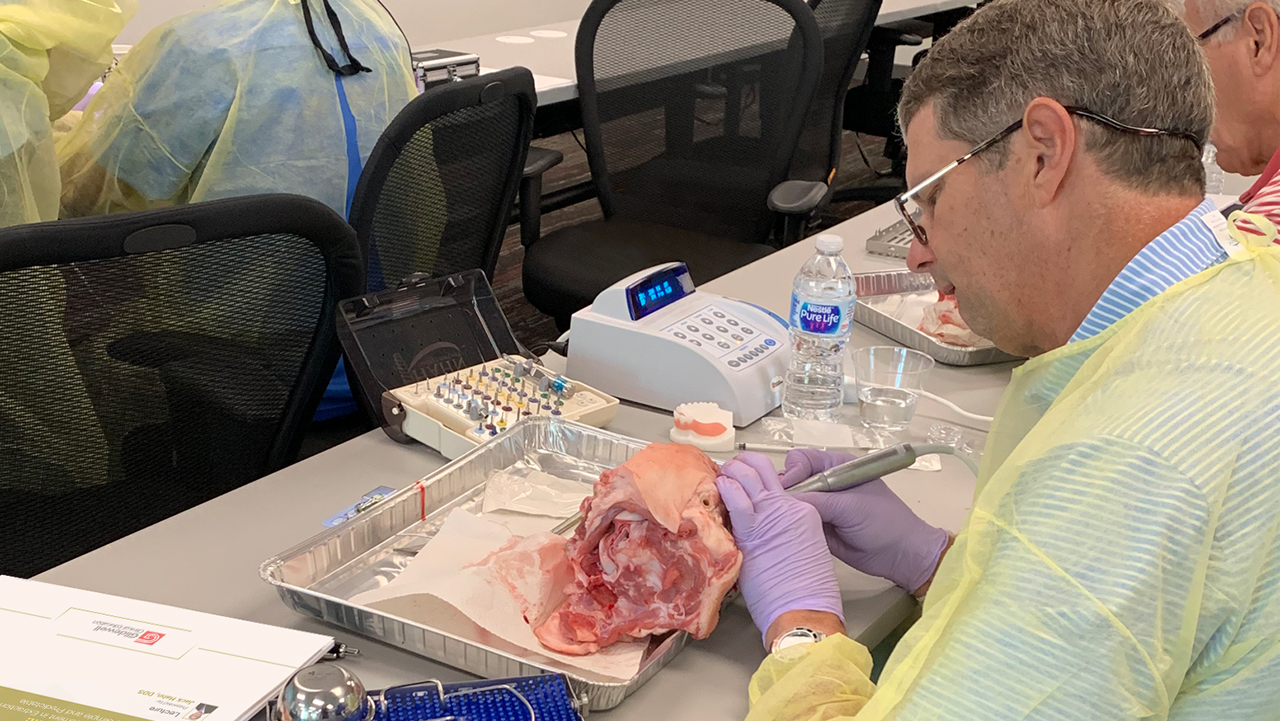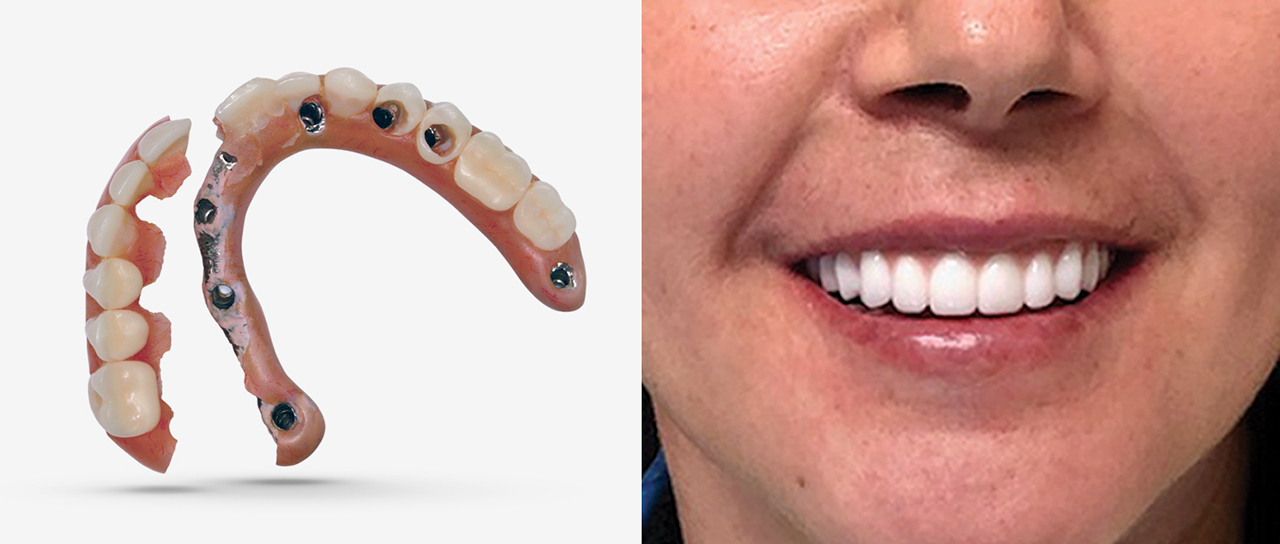2201 Dupont Dr., Irvine, CA 92612
© 2025 Glidewell. All rights reserved.
800-854-7256 USA
Dr. Jack Hahn shares tips learned during his 50-year career placing and restoring implants.

“Ask Away” is a recurring Smile Bulletin column that features questions posed by dentists at live and online courses offered by Glidewell Clinical Education. This provides attendees — and Smile Bulletin readers — an opportunity to get useful clinical tips, tricks and guidance from dentists who are experts in their respective fields. Here, implant pioneer Dr. Jack Hahn shares his wisdom learned over the course of his 50-year career placing and restoring implants, answering questions on topics ranging from bone grafting, to impression-taking, to full-arch restorations.
What is a good introductory course you can recommend for implant placement?
Dr. Jack Hahn: Glidewell has several implant courses available through Glidewell Clinical Education, all of which have a hands-on component. The objective of each of the presenters at these courses is to teach doctors how to place and restore implants safely with predictable long-term success. Visit glidewellcecenter.com to register for live courses, and you can also find an array of free online CE courses to get you started at glidewelldental.com/education.
The world-renowned Misch International Implant Institute has an outstanding comprehensive continuum. I’ve had the honor of teaching courses there in the past, and I take great pride in the fact that the Hahn™ Tapered Implant serves as the institute’s official implant system. Everything they teach is based on the latest scientific literature, and thousands of general dentists have learned to place implants there.

For clinicians looking to add implant surgery to the services they offer at their practices, Glidewell Clinical Education offers an array of in-person courses.
If there’s a fenestration present at an extraction site, do I always need to use a barrier membrane?
JH: While many dentists use barrier membranes when grafting a fenestration at an implant site, I prefer to use a Newport Biologics™ Resorbable Collagen Plug. After grafting the defect with Newport Biologics Mineralized Cortico/Cancellous Allograft Blend, I add saline to the collagen plug, flatten it like a pancake and use it just like a membrane. It stays in place, it’s osteogenic, and you don’t have to go back in to remove it. I suture the site the same as you would with a membrane, and I always get excellent healing and a predictable outcome for the implant.
When considering short dense bone in the mandibular area, some speakers recommend the use of parallel-walled implants instead of tapered implants. What is your opinion on using parallel-walled implants?
JH: Implants with a tapered body design are more ideal because they fit into areas of limited bone better and are designed to support the vertical load just like a natural tooth. Implants don’t like a lateral load and neither do teeth. These are the precise reasons I created the tapered body design for the NobelReplace® implant. My latest implant, the Hahn Tapered Implant, combines a tapered body design with aggressive threads for high primary stability and a machined collar for flexible implant positioning, and as someone who has placed implants for 50 years now, I can say with confidence that you’ll get a better outcome than you would with a parallel-walled implant.
Another advantage of tapered implants is that they can be placed in anatomically constricted areas using a wider diameter than you could with a parallel-walled implant, providing a wider prosthetic table that helps to reduce stress and preserve crestal bone.
For an in-depth comparison of how tapered and parallel-walled implants perform, I highly recommend the new Chairside® magazine article summarizing Dr. Christopher Resnik’s exciting new study on this topic.
Why don’t you restore your full-arch implant cases with acrylic hybrid dentures?
JH: I used to do a lot of acrylic hybrids and encountered problems time and again. The acrylic fractures, the teeth break, and the appliance gets stained and becomes odorous. Now that full-arch implant restorations can be made from monolithic zirconia, I’ve switched completely over to the BruxZir® Implant Prosthesis. The restoration is milled in one piece, so there’s no chipping or breaking of the teeth, and the prosthesis doesn’t smell or stain. Over the long term you aren’t spending time repairing something that is going to break again in another spot. I save so much time now that I’m not dealing with repairing acrylic hybrids, and I don’t have to worry about disappointing my patients, who spend a considerable amount of money on this kind of treatment and have every reason to expect that the restoration will last.

After experiencing numerous problems with acrylic hybrid dentures (left), Dr. Jack Hahn now restores all of his full-arch implant cases with the BruxZir Implant Prosthesis (right). Milled from a block of high-strength solid zirconia, the BruxZir Implant Prosthesis avoids the chipping, stains and fractures that tend to compromise acrylic hybrids.
What type of material do you use for the final impression of the implant site, and do you go with the open-tray or closed-tray technique?
JH: I inject medium-body vinyl polysiloxane (VPS) material around a closed-tray impression coping. Then I inject heavy-body VPS into the tray. It’s what works best in my hands. I designed the Hahn Closed-Tray Impression Coping with deep vertical and horizontal undercuts that really help with holding its position within the impression. You can actually hear them pop when you put them back in the impression after the material has set and you’ve removed the tray from the patient’s mouth.
How do you suggest patients clean under a fixed full-arch implant restoration like the BruxZir Implant Prosthesis? Do you occasionally remove the restoration to clean it? And are there concerns regarding peri-implantitis in the long term if the prosthesis is not cleaned adequately?
JH: Maintaining proper cleanliness of the restoration starts with the contours of the intaglio surface. When we do fixed prostheses, it is important to remove flanges and have the most convex intaglio surface possible, which helps prevent the accumulation of plaque, food debris and other buildup. If you’re doing a provisional, practice flossing and toothbrush position with the patient to make sure they’re able to clean the prosthesis. You may also need to modify the prosthesis design to create space to allow the patient to insert the floss if they are having difficulty.
Next, I always recommend multi-unit abutments (MUAs) for full-arch cases. This allows you to remove the prosthesis, if necessary, without disrupting the implant-soft tissue connection. It is also much more comfortable for your patient when you are seating the prosthesis. As far as home care, I always recommend a water flosser and floss threader combination.
I might also note that the clinical workflow for the BruxZir Implant Prosthesis includes a provisional and is delivered over multi-unit abutments, which certainly helps address a few of the key concerns I’ve outlined here.

Dr. Hahn created the original tapered implant design to better support a vertical load. The tapered shape also eases the positioning of the implant in areas where limited bone volume is available, which has led to widespread adoption of this design feature.
If you are restoring single implants that are opposing one another, what type of crown do you suggest?
JH: I only use BruxZir Zirconia for my implant restorations, and they do great opposing one another. I’ve never had any problems and it’s the most clinically proven dental zirconia out there.
With the Hahn implant, is it acceptable to position the machined collar at the bone crest, or does it have to be subcrestal?
JH: You need to get the threads subcrestal, but you can position the machined collar level with the crest of bone or about 1–1.5 mm above it. I’ve designed several implants with a machined collar, and when the patients come in for recall, the crestal bone levels are outstanding. Additionally, studies have shown that machined collars help mitigate the adhesion of bacterial plaque to the implant.
Have a question for one of our clinical experts? Email hello@glidewell.com, and you could see your question answered in a future “Ask Away” column.
NobelReplace is a registered trademark of the Nobel Biocare group.
Send blog-related questions and suggestions to hello@glidewell.com.


